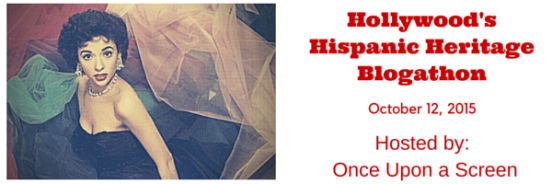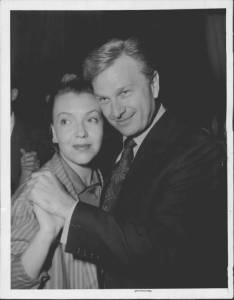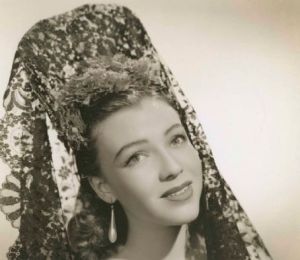La Madrina Margo Albert

Celebrating Once Upon A Screen‘s Hispanic Heritage Blogathon.
Lost Horizon (Frank Capra, 1937) was my first Margo Albert movie. While reading Anthony Quinn’s autobiography One Man Tango, her name was further fixed into my memory after seeing a photo still of her dancing in Viva Zapata (Elia Kazan, 1952). Finally after watching her flamenco dance in the Val Lewton produced classic The Leopard Man (Jacques Tourner, 1943) did she peak my interest.

Margo with husband Eddie Albert
My appreciation for flamenco began with flamenco dancer Rita Hayworth. It turns out Margo studied dance under Rita’s father, Eduardo Cansino, and made her professional debut as a child. Call me shallow but sometimes all it takes for me to adore an actor is a flamenco connection. I suddenly became a Margaret O’Brien fan when I learned her Spanish mother and aunt were flamenco dancers. Although I had been an Ida Lupino admirer for decades, overnight she moved up the ranks of my favorites because her sister, Rita, was a flamenco dancer. Margo Albert, or simply Margo, could have just remained one of my “favorites” by flamenco default but luckily I researched her and found her one of the most admirable actresses in Hollywood history.

Her commitment to the arts and Latino communities endeared me. She was born in Mexico City as Maria Margarita Guadelupe Teresa Estela Bolado Castilla y O’Donnell. A little Irish too just like her former Mexican co-star Anthony Quinn. She came to the United States as a child becoming a US citizen in 1942. She married actor Eddie Albert in 1945. Here she is at 2:55 minutes discussing her fear of falling in love with him due to her goals in life.
In the early 1950s, the Alberts had a nightclub act directed by Herbert Ross that played throughout the country. They also recorded albums together along with Spanish guitarist Vicente Gomez. Here is a video of them singing duets. Margo’s voice starts at 50 seconds. There are also clips describing her life as well as from films she appeared with her husband including I’ll Cry Tomorrow (Daniel Mann, 1955).
In the late 1940s she and Eddie started teaching arts and music to children in East Lost Angeles. In this clip starting at 58 seconds, Margo discusses her classroom instruction.
Margo later became active in the neighborhood movement to prevent the City of Los Angeles Parks and Recreation Commision demolition of Lincoln Park’s historic boathouse. In 1970, this movement to raise funds to save it led to the creation of Plaza de la Raza, a Latino Community Cultural Arts center inside Lincoln Park.

Plaza de la Raza
As one of the founders, Margo was known as Madrina, the godmother. She taught drama there in 1978. She was artistic director and chairman of the board for many years. The family continued its commitment to the center after Margo’s death in 1985 with Eddie Albert as chairman and their son on the board.The center now includes the Margo Albert Theater, an outdoor stage and an art gallery.
From September 15-October 15 of this year the theater has been hosting a Latinos in Hollywood photo exhibit honoring Latino actors of Hollywood’s past and present.


The Plaza is celebrating its 45th year with vintage photo exhibitions including this one of Margo.

Check out the website for more information on the 45th anniversary at
http://www.plazadelaraza.org/media/our-story/
You can also follow on Facebook and Twitter.
In addition to the Plaza, Margo was also a board member of the National Council of the National Endowment for the Arts, served on the President’s Committee on the Arts and Humanities and on former Los Angeles Mayor Tom Bradley’s Advisory Committee on Cultural Affairs. Yet Plaza de la Raza was her great civic and cultural love. Bradley said. “Without her, this cultural center would not have happened and we would not be here.”
Pingback: ¡De Película! Hollywood’s Hispanic Heritage Blogathon | Once upon a screen…
I love that she had such an important cultural impact, thank you for sharing an interesting story.
-Summer
LikeLiked by 1 person
I’m curious if you had heard of her before since you are from the Los Angeles area.
LikeLiked by 1 person
The only thing I know about her is that she was in Viva Zapata and I knew she was married to Eddie Albert.
My family is from Los Angeles and I’ve spent some time there, but I grew up in Germany and Northern California, so while I know Los Angeles well, I am far from an expert.
unless you are looking for a good restaurant 😉
-Summer
LikeLike
I didn’t know La Madrina, but BunnyBun’s compelling and smartly written blog makes me want to. Thanks BB for opening my eyes to this amazing woman.
LikeLiked by 1 person
She was amazing. Thank you. She and Eddie Albert were a great match. They both had their causes and wanted the world to be a better place.
LikeLike
It’s funny how a small detail or personality quirk can endear you to a personality (for example, I’m an only child and I always feel a kinship with anyone without siblings, regardless of if I know them!). The only film of Margo Albert’s I’ve seen is Viva Zapata, but clearly there was much more to her than that role – I look forward to discovering it!
LikeLiked by 1 person
I feel I’m the queen of small details endearing me to a personality. I have a strong jaw so I adore Gena Rowlands and Salma–I read your post. I have heavy eyebrows (but not like Frida’s) so I adore Jennifer Connelly. Karl Malden is a crush because he had a long and hopefully happy marriage. Plus he spoke another language. Thank you for reading the post. It was a fun blogathon. I always enjoy your contributions and replies.
LikeLike
I very much enjoyed the post, and her voice is lovely. Eddie’s? Not so much. 🙂
LikeLiked by 1 person
Thank you very much but poor Eddie. 😦
LikeLike
Maybe he had hidden depths, but from Oklahoma to Green Acres, the actor never did much for me. Ah well.
LikeLiked by 1 person
May I ask about the photo of Margo wearing a mantilla. Could you share the source and context. Thanks
LikeLike